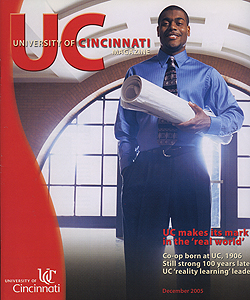University of Cincinnati Co-op: 100 years of success
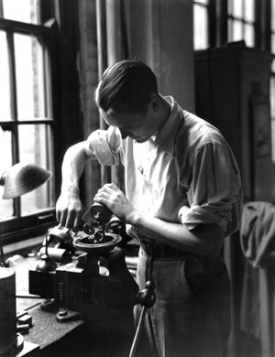
Photos/courtesy of UC Archives and Rare Books
Herman Schneider's contemporaries ridiculed his plan to send university students to work in factories. Business owners worried about fraternity boys mangling their machinery. Faculty pictured grimy-fingered factory boys in class. The University of Cincinnati Board of Trustees only narrowly approved a one-year trial of cooperative education in 1906, and declined to take responsibility if the experiment flopped.
Despite the skepticism, Schneider was elated to have even grudging permission to prove the value of his plan. Although he had joined the University of Cincinnati faculty just three years earlier at the age of 31, his ideas about combining theoretical classroom knowledge with part-time work experience had been percolating since he taught engineering at Lehigh University.
What Schneider observed -- and also verified by analyzing graduates' records -- was that the students who understood classroom concepts quickest and best had either worked while attending college or on summer breaks. He also believed that his own work history -- clerking in his father's general store, laboring as a coal-breaker at a Pennsylvania mine and assisting in an architect's office -- benefited his education. So, when Lehigh ignored his cooperative learning ideas, the professor took a post at the University of Cincinnati.
At UC, Schneider began speaking and writing about ways to improve technical education. His 1904 article in the University News caught the eye of Charles Dabney, UC's progressive new president, who liked what he saw. Two years later, Dabney would recommend that the young professor be named the first dean of UC's newly formed College of Engineering and would boast to industrialist Andrew Carnegie that the university considered Schneider "one of the most original thinkers in the educational world."
Local industrialists Frederick Geier, the Cincinnati Milling Machine president, and Ernest DuBrul, president of Miller, DuBrul, Peters Co., appreciated Schneider's ideas. They convinced three of their fellow UC Board members to give him a chance -- just enough to win approval in a 5-to-4 vote. John Manley, influential leader of the Cincinnati Metal Trades Association, helped Schneider sign up a dozen member firms willing to hire co-op students.

They may not look nervous, but UC's first co-ops were taking a chance in choosing this new form of education.
In September of 1906, all that was needed to begin the "Cincinnati Plan," as the innovation came to be known, was a willing bunch of students. These young men would be entering unknown territory, gambling that the experiment would produce superior results and spending nearly two more years in school than their traditional counterparts would.
One candidate, who would later be UC's first co-op graduate, walked into Schneider's office with no intention of attending the university, let alone its co-op program. George Binns, Eng '11, was on his way from Kentucky to the Naval Academy at Annapolis when he got off the train in Cincinnati to visit a friend. The friend's father, board member DuBrul, invited the boys to go along with him to the university where he had a meeting with Schneider.
According to George's son, Jack Binns Sr., Eng '40, the dean must have been quite the pitchman. "At the end of the visit, he had really sparked my father's interest and even suggested my father give up his appointment to the Naval Academy and stay in town to try on the new University of Cincinnati program for size. And my father said, 'By golly, I think I will.'"
In all, there were 27 men in the first co-op class: 12 mechanical, 12 electrical and three chemical engineering students. Divided into pairs, one would attend classes for a week while his "shop partner" was working at a local company; the roles reversed the following week. On Saturdays, they would meet with the dean to talk about their experience.
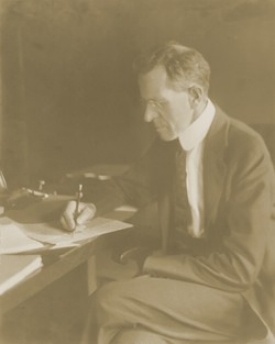
Dean Herman Schneider
The first year the University of Cincinnati offered cooperative education, some of the co-op students were disappointed that the Cincinnati Milling Machine Co. had not requested any co-op workers. Dean Herman Schneider responded by secretly arranging jobs for two students through a friend employed there. UC alumnus Jack Binns, Eng '40, told what happened the next time the dean saw company president -- and UC board member -- Frederick Geier:
"Herman let the cat out of the bag by asking Geier how his co-ops were working out. Geier replied that he didn't have co-ops, that the co-op plan would work in some organizations but not his. Herman then had to confess that he'd snuck two students in.
"Geier was pretty angry about the wool being pulled over his eyes, and Herman had to promise that when Geier got back to his office and checked it out, if the co-ops weren't doing well, Herman would repay all that they'd been given in terms of salary. And, if they were doing well, Geier had to accept more co-ops."
The executive checked with his foreman, who called the co-ops "the best men I've got." Geier, who had to admit that this was probably the only way he would have started employing co-ops, told Schneider: "Send out two more." Twenty years later, the company would be asking to hire the entire freshman class of mechanical engineering students.
Positive reviews of UC's experimental co-op program convinced the board of trustees to continue it. Four hundred students applied for the 70 spots available in 1907, and by 1919, nearly 800 co-ops were working in 135 local companies. UC cancelled the traditional engineering program in 1920, and co-op became mandatory for all engineering and business students.
Around the country, other universities began to build programs modeled on Schneider's "Cincinnati Plan." Northeastern University, Boston, was the first (1909), followed by the University of Pittsburgh (1910), the University of Detroit (1911) and the Georgia Institute of Technology and Rochester Institute of Technology (1912). Even Harvard joined the fold in 1920, with former UC co-op Charles Lytle, Eng '13, directing the new program.
When UC's president, Charles Dabney, described the success of cooperative education to other academic leaders, he no doubt told them about his visit in about 1911 with steel baron Andrew Carnegie. The industrialist had endowed Pittsburgh's Carnegie Institute of Technology (now Carnegie Mellon), and was bragging to Dabney about the school and its fine technical equipment. Then he paused and said, "I hear you have no shops for your engineering college in Cincinnati. How in the world do you get along without them?"
Dabney explained that through the university's cooperative program, owners of the city's factories hired student workers and gave them real-world experience that enhanced their academic learning. Carnegie was irked.
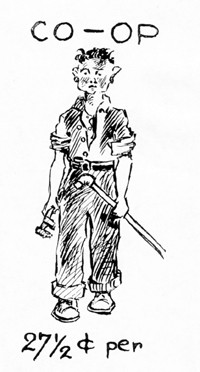
Cartoon from UC student magazine,"The Cooperative Engineer," promised hard manual labor for wages just a little more than a quarter an hour.
"Then you mean to tell me that I have spent $13 million dollars building shops for my school in Pittsburgh when I might have used the shops they already had there?" he grumbled. "And since then I have had to keep them up-to-date at great expense." No doubt Dabney tried to appear sympathetic.
As more universities in the U.S. adopted the Cincinnati Plan -- along with schools in England, Germany, China and Canada -- Dean Schneider realized that co-op educators needed an opportunity to meet and share information. In 1926, he invited them to come to UC to form an Association of Cooperative Colleges and attend ACC's first convention. Today, cooperative educators even have a World Association whose members represent 43 countries.
In 1920, UC's program increased its range of co-op disciplines, opened opportunities to more students and the university became the first in the U.S. to admit women to preparatory programs in engineering. The push came not from the board or even Dean Schneider. It was a student's aunt who got the ball rolling. Learning that her niece, Ruth McFarlan, Eng '25, was eager to study engineering, Anna McFarlan asked Dean Schneider's secretary -- who was also her friend -- to suggest that engineering be opened to female students.
That fall, seven "co-eps," as they were called, enrolled in either chemical engineering or commercial engineering (business). They faced formidable odds. Some companies that employed men co-ops would not consider hiring women. Even male students referred to their peers as "the poor dears" and admitted, "the girls were very coldly received by both employers and co-workers."

UC opened all its engineering programs to women students during World War II as part of the war effort. A chemical engineering lab is pictured.
In spite of obstacles in the 1920s, women students continued to apply to the University of Cincinnati co-op engineering program in increasing numbers, from seven to 22 in only three years. One alumna explained that she enjoyed being a "pioneer," and another said that achieving her degree gave her "a sense of independence and self confidence."
Nevertheless, chemical engineer Helen Norris Moore, Eng '25, eventually chose to return to UC for a faculty post, instead of continuing to struggle for acceptance in industry:
"In the first place, women were not so desirable in chemical industries," she recalled, "and in the second place, I had tacked a 'Mrs.' to my name. Somehow or other, those two conditions made things rather difficult.
"Occasionally the employer would take a chance if the woman agreed to accept a few dollars a week less. A lucky chemical engineer might get a job doing routine analysis in the laboratory of some chemical plant. The duties of answering the telephone, caring for the filing system … and even washing the luncheon dishes were very apt to be added."
Nearly 17 years would pass before the country cried out in desperation for women with engineering knowledge and technical skills during World War II. Before then, America's social, cultural, educational and workplace restrictions were too strong. It wasn't until 1943 that the university opened all of its engineering courses to women, and companies readily hired female co-ops.
No doubt, one of the stumbling blocks to employment of all co-ops at the beginning of the 1930s was America's Great Depression. UC's resourceful faculty tried exceptional methods, such as transporting co-ops to factories across Ohio. When they located a job, they left a student to take it.
Professor Ralph Van Wye, Eng '24, even played detective to assist co-op John Sherman, Eng '38. Just after Sherman left for Michigan where his family was camping, the local electric company called UC with a job. Van Wye didn't know how to reach his student, so he talked to the landlord, neighbors and Sherman's friends. Because the campground had no phone, the professor called the nearest post office, asking them to get word to Sherman.
"When Professor Van Wye got me on the phone, he was yelling, 'Where the hell have you been? Do you want a co-op job or not?'" Sherman chuckled. "Heck, yes," he answered and hurried back to Cincinnati.
As much as UC's co-ops needed work, the Queen City needed their skills and energy. Co-ops left their imprint on Cincinnati's landscape when they helped drain part of the old Miami-Erie Canal so Central Parkway could be built. They did construction on the city's ill-fated subway, plus surveying and drafting for the new suburban communities, Mariemont and Greenhills. They handled jobs from field engineering to pick-and-shovel chores for Union Terminal and Western Hills viaduct, and helped construct the Carew Tower office building.
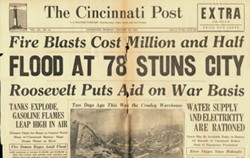
Co-ops also served -- without pay -- during one of the city's worst emergencies, the 1937 flood. Although the university was not in danger, it had to close in the middle of exams, so that Kentucky students could make it home before rising water blocked bridge entrances. The flood would leave 50,000 Cincinnatians homeless.
UC mobilized its co-ops to guard and provide fire protection at Music Hall, to sandbag bridges and levees, to distribute provisions to flood victims and to staff a campus communications hub. Electrical engineering students operated the campus radio station around the clock for two weeks, eating and sleeping in shifts. They provided the only means of communication in the city during the worst stages of the flood, a service that earned them special recognition from the Federal Radio Commission.
A few years later, World War II had a dramatic impact on UC's program. Never officially suspended, work experience for co-ops was shortened as students entered the university early, followed an accelerated schedule and graduated early. Service in the armed forces found co-op grads working with FBI intelligence in Peru, running factories in Liberia, building bridges (under fire) in Italy, serving with the signal corps in Iceland, teaching chemical warfare in Virginia and blowing up enemy installations on the Normandy beaches.
After 1945, nearly 20,000 students descended on UC, many of them veterans taking advantage of the G.I. Bill. More than 2,000 were co-ops in the College of Engineering, including 29 women. It was a good time for co-ops. They were in demand -- being offered professional work, rather than introductory jobs. Unless the student was black.
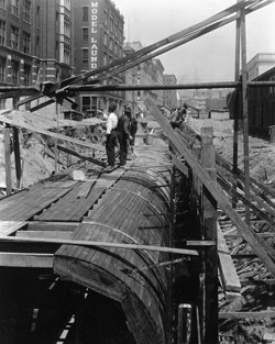
UC co-ops helped build the first phase of Cincinnati's subway project.
The University of Cincinnati co-op program had never been off-limits to blacks, but students were required to have co-op jobs. In the racially segregated America of the 1950s, employers would not accept African- American students. "We'd send a well-qualified African-American junior or senior co-op on an interview with young, less-qualified white students," former program director Sam Sovilla, COB '62, MA (Ed) '69, confirms, "hoping the employer would opt to hire the African-American."
Still, a small group known as the "Pioneers" broke co-op's color barrier, beginning with Henry Thomas Brown, Eng '55, Hon Doc '01, and Clark Beck, Eng '55, MS (Eng) '69. Brown recalls that after applying to study chemical engineering in 1949, he received a letter from UC, inviting him for a summer interview. He asked a lawyer what he should expect.
"He said, 'You'll be interviewed to tell you the hardships of engineering, to be told that no black has ever been there before, and they've never had a black graduate.' That's just what happened, too. It was done to discourage me from entering, but at the end of that interview, I just said, 'Thank you. I'll be here in September.'"
Brown's grades were so good that he made the dean's list every quarter and narrowly missed graduating first in his engineering class, but the university could not find him an engineering co-op. Except for temporary positions, the only opening was a laborer's job in a Republic Steel factory, so he reluctantly took it. He worked his remaining co-op quarters in campus labs.
Beck's determination was equally strong. He earned a mathematics degree in Virginia and intended to study engineering at Purdue, but was turned away. "Mom and I drove straight from there to UC," he remembers, "because I'd heard of the co-op program.
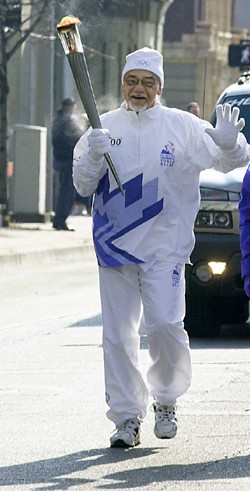
One of the co-op "pioneers" who broke the color barrier, Clark Beck, Eng '55, MS (Eng) '69, carried the Olympic torch through the Dayton, Ohio, downtown streets for the 2002 winter games in Salt Lake. Photo/Lisa Ventre
"Even though I arrived unannounced, the dean came out of a meeting to see me. He looked at my transcript and said, 'You can come if you want to, but you'll catch hell.'
"I decided I would be an engineer if it killed me -- just because someone told me I couldn't. It almost did kill me," Beck admits.
Living in a single, poorly heated rented room, surviving on canned foods his mother sent, Beck was often sick. He says he made his way through it, "day by day," and obtained a co-op job at Wright-Patterson Air Force Base.
In the mid-1970s, federal funding was approved to help universities implement and expand co-op programs, a move that UC's Sovilla calls the "most significant force in cooperative education's evolution over the modern era." UC was awarded funding to create an Employer Training Center, the only one of its kind established through Title VIII funding.
A more recent development is international co-op. Although there had been students with work assignments in other countries, the establishment of a program to "continuously and deliberately" prepare students to live and work abroad began in 1990 in the College of Engineering. Providing 300 hours of intensive cultural and language preparation, the program has assisted approximately 1,200 students to successfully co-op in Germany, Japan, Chile and Mexico.
With such a rich history of dedicated educators, bright students and supportive employers all working to advance achievement and learning, it is no surprise that the University of Cincinnati is among the top 10 programs in the nation, as ranked by the U.S. News and World Report for the last four consecutive years.
Did Herman Schneider know how amazing his idea was when he created cooperative education? What would he think of today's co-ops who analyze military aircraft, design clothing for the rich and famous, test satellites before launch, teach computer sketching to seasoned designers and thrill moviegoers with fantastic effects? Surely it would make him smile.
Related articles:
1930 grad shares co-op's 100th birthday.
Campus traditions born of "hobby hour" mandate.
World Association for Cooperative Education
A brief history of the College of Engineering & Applied Science
